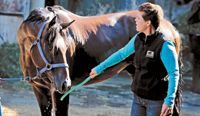Feeling their pain: One veterinarian explores her ability to communicate with patients
Veterinarian Jodie Santarossa says she actually experiences patients' discomfort.
The first time Jodie Santarossa, DVM, communicated with one of her veterinary patients, she was shy to admit it.
"I kept wanting to dismiss what was happening as coincidence," says Santarossa, owner of BrightSide Vet—a practice that focuses on equine medicine, especially horses involved in elite sporting endeavors—in Sherwood Park, Alberta. "I'd touch a spot on the horse that I perceived as painful in my own body and the horse would react."
From migraines to temporomandibular joint (TMJ) disorders to burning muscles, Santarossa says she feels empathic pain for patients and can sometimes physically feel their symptoms. While she's becoming increasingly more comfortable with this form of communication, she wasn't always so sure. For one, she didn't think the Western veterinary community would approve. And secondly, she wasn't sure how to explain the events herself.

Jodie Santarossa, DVM, interacts with a freshly-showered Thoroughbred stud named Rascal Cat. Santarossa is so in touch with her patients and racehorses that she can sometimes sense where their pain is located on her own body. (PHOTO COURTESY OF DR. JODIE SANTAROSSA)
"I was very much in the closet," Santarossa says. "I started to have these experiences, and I had this internal struggle where I could believe it was real, but there was no way for me to validate it."
For the past six years Santarossa has been on a search for validation and continues to explore and study the world of "energy medicine," as she calls it. A few months back she attended an animal communication workshop near her practice instructed by Carol Gurney, author of The Language of Animals: 7 Steps to Communicating with Animals. Gurney is also the founder of the Gurney Institute of Animal Communication in Agoura, Calif., which offers the only professional animal communication certification program in the world.
"Carol is teaching us to discover the innate ability within all of us to listen on a deeper level, to perceive things with a greater level of conscious awareness, specifically in the realm of animal communication," Santarossa says.
Does this mean every person leaves the seminar ready to have a heart-to-heart with her next patient? Far from it, Santarossa says. Like mastering any profession, becoming an animal communication expert takes extensive education, experience and time, she says.
"There's a balance between the art and science," Santarossa says. "You can have that feeling or awareness, but in order to validate what we're doing as vibrational practitioners, we need to have the scientific information down so that it's validated to our clients, our skeptics and our colleagues."
She's actually in the midst of an Eastern meets Western medicine research experiment right now. She's combining forces—quite literally—with certified animal chiropractor Kyla Awes, DC, of Plymouth, Minn., and Bart Halsberghe, DVM, of the Animal Rehab Institute in Gilroy, Calif., and the Peninsula Equine Medical Center in Menlo Park, Calif. These two also believe in the integration of Eastern and Western philosophies.
"The three of us do our exams—I do my energetic reading," Santarossa says. "And we've started to correlate the sensations in my body with Kyla and Bart's findings."
Santarossa is the first to admit that the symptoms she feels aren't a substitute for a diagnosis and that objective metrics are essential to monitoring a patient's progress. She still allows about 45 minutes to complete the "traditional" physical exam, taking the horse's temperature, pulse and respiration rates and collecting measurements. As a sign of respect, during this process, Santarossa asks the animal questions like, "May I please examine in your mouth?" and "Can I look in your eye?"
"I speak to them like I would if I was a human doctor talking to a patient," Santarossa says. "It's asking permission and acknowledging that they're there—not like we're having all these conversations about them in their presence."
After collecting all of the hard data, she'll stop for a moment. This is where the more controversial evaluation comes into play—she'll do an energy reading of her own body.
"I'll be aware that my left deltoid is burning, I have a pain in my groin, I have TMJ pain on my right—and I'll take note of all of these things," Santarossa says.
Some of the conditions she feels aren't identified anywhere else in the horse's exam. Santarossa says it's her chance not to replace science with her energy reading, but to simply contribute more information to the patient's comprehensive medical assessment.
"How many times have my clients jokingly said, 'If only your animals could talk'?" Santarossa says. "It turns out they can. I just didn't know how to listen previously."
Newsletter
From exam room tips to practice management insights, get trusted veterinary news delivered straight to your inbox—subscribe to dvm360.